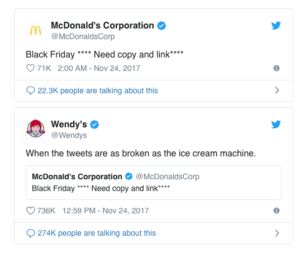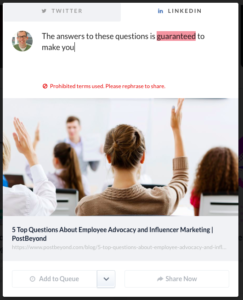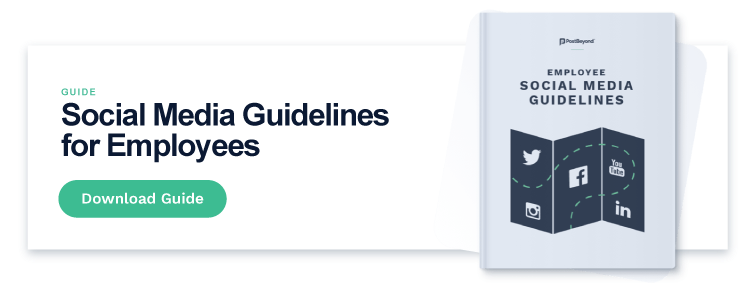Social media has presented an opportunity for brands to gain visibility and connect with their audiences. Companies are leveraging social media to engage in conversations with their audience, however, employees are also following suit.
The lines between professional and personal brand have blurred leaving brands looking for ways to better control and manage their image on social media. Living in the digital and social media age makes this a lot more difficult as one accidental tweet can cause lots of embarrassment – sometimes even costing a company millions of dollars. Competitors can be quick to jump on mistakes as well. Wendy’s is famous for trolling McDonald’s’ Twitter posts.

Social Media Marketing is one of the best ways to build a brand presence online, but it’s also easy to misuse and once a mistake is made it can live on forever. And, while mistakes do happen, there’s a lot of social media errors that can be avoided if the proper procedures, people and technologies are in place.
These are the top six steps brands need to follow to ensure both their brand and employee social media profiles are protected from posting mavericks.
1) Build a Social Media Policy
If you don’t know, you don’t know. Leaving what your brand deems acceptable (or not) up for interpretation is asking for trouble. Creating a social media policy works two ways:
- It holds employees accountable for their social media behavior
- It creates awareness for social media as a legitimate tool for business
When your social media policy is clear, your employees have a better understanding of the rules and regulations for social sharing. They will also feel more empowered to promote the brand message on social media.
Here are the topics your policy should cover:
- Brand vision and voice
- Goals of social media for the organization
- Roles (i.e. which departments/titles/offices can and cannot post)
- Rules, Privacy, and Regulations that must be followed
- Consequences and legal risks
Looking for more guidance in developing a policy? Download your guide to building an Employee Social Media Policy
2) Develop an Approval Process & Team
Now that there is a clear what and how there needs to be who. As in who will oversee the policies to make sure everything stays on the right track. Like the McDonalds example above, a little oversight can go a long way. Creating a clear and simple approval process will cut down on the time it takes to review posts as well as create a go-to person (or committee) in case there are issues.
It is important to consider what needs to be approved such as imagery and content as well as how long will it take for the approval. Aligning this with other departments and making appropriate work back schedules for large events and social campaigns will help to decrease last-minute scrambling which often results in mistakes.
The team lead should build out a plan of how many days it will take to create the social content, get legal sign-off, possibly client sign-off, approval from the Social Media Manager, and how it will be shared throughout the company. Go to step 5, if you’re curious how technology can streamline this process.
3) Stay in Tune with Employees
Social media is all about being social. If employees are unhappy or disengaged they may socialize that. One very important way to mitigate the risk of social media mavericks is to stay in tune with how employees are feeling about the company culture and giving them easy access to an offline platform should they need to voice concerns.
Explaining to employees why social media is not the place to be controversial as well as how their posts reflect the company brand, as well as their professional brand, is important. While no one should be censuring, it is important to remind employees about both the organizational and personal branding that can be gained (or lost) on social.
Before encouraging employees to get active on social media, consider if this is a good time. Is morale down? Were there layoffs? Or is the company thriving, landing big clients, and really investing in its employer branding. If it’s the latter then it’s time to encourage social media marketing. Just make sure employees have read the policy and know where to go to voice their questions or objections. Conducting social media training helps employees to feel comfortable and equipped with the right knowledge to succeed on social media.
4) Implement Social Listening
Keeping track of what is being said about your organization and the sentiment of your brand is essential for social media brand building. It’s a vast social media world out there, a lot can happen (and be missed) in an internet minute. Twitter alone has over 87,500 Tweets sent per minute making it impossible for a human to catch everything that mentions (or alludes) to a brand.
This is where social listening tools come into play. Remove the detective work by employing technology that does the sleuthing for you. Employ a person or team to handle any negative feedback that’s returned. Oversharing, false claims (both intentional and unintentional), customer complaints, employee complaints … these all need to be addressed so they do not cause further damage.
In addition to catching potential red flags or full-blown trolls, social media listening tools can also identify happy customers that can be repurposed into testimonials as well as help to identify trends and topics in your industry. This is invaluable knowledge for both your social media and content teams.
5) Leverage Social Safeguards & Employee Advocacy Platforms
Make it easy and safe for employees to share on social media. This is where technology can really shine. If you want your employees to share then make it easy for them. Employee Advocacy platforms like PostBeyond create one central repository of content (all pre-approved) that employees can easily share in a few clicks. It will guide them on what content they should be fueling their feeds with, ideas on what makes a good post caption as well as guardrails should they accidentally cross the line.
All brands (especially those in regulated industries) will have types of content and lists of terms that cross brand and regulatory lines. Often, these can be innocuous terms that employees may not even realize. Leveraging technology to showcase what is a limited term or stop a post from being shared should it contain something deemed unacceptable keeps the horse in the barn versus having a Social Media Manager and Compliance team have to handle some quick clean up.

6) Have a Crisis Plan
Even the most thought-out plans and technologies cannot prevent everything. There may be a day when an angry employee lets loose or a photo with hidden details slips through. In addition to the 6 preemptive steps above, there should also be a plan to handle a social media crisis. Controversies happen and covering them up often creates more of a mess. The key to social media is, to be honest, and brief. Address the issues, what the resolution will be, and who needs to be involved.
While mistakes do happen, these social media snafus could often be avoided with the proper policies, procedures, and technologies all working together to make your brand shine on social. Following these 6 steps will help to keep rogue mavericks from sabotaging your social media marketing.






